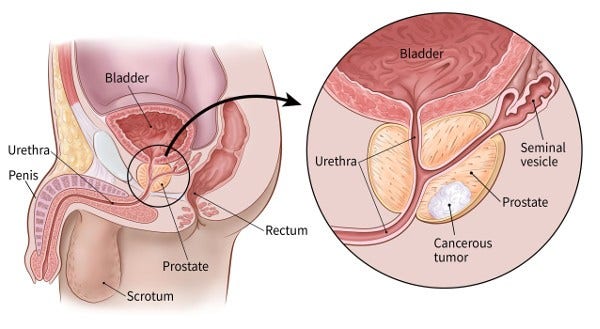What Is Prostate Cancer?
Prostate cancer begins when cells in the prostate gland start to grow out of control. The prostate is a gland found only in males. It makes some of the fluid that is part of semen.
The prostate
The prostate is below the bladder (the hollow organ where urine is stored) and in front of the rectum (the last part of the intestines). Just behind the prostate are glands called seminal vesicles, which make most of the fluid for semen. The urethra, which is the tube that carries urine and semen out of the body through the penis, goes through the center of the prostate.

The prostate tends to grow as a man ages. In younger men, it is about the size of a walnut, but it can be much larger in older men.
Types of prostate cancer
Almost all prostate cancers are adenocarcinomas. These cancers develop from the gland cells in the prostate (the cells that make the prostate fluid that is added to the semen).
Other types of cancer that can start in the prostate include:
- Small cell carcinoma (small cell neuroendocrine carcinoma)
- Other neuroendocrine tumors (including large cell carcinoma)
- Transitional cell carcinoma
- Sarcomas
These other types of cancer are rare. If you are told you have prostate cancer, it is very likely to be an adenocarcinoma.
Some prostate cancers can grow and spread quickly, but most tend to grow slowly. To learn more, see the information on prostate cancer grades in Tests to Diagnose and Stage Prostate Cancer.
Possible pre-cancerous conditions of the prostate
Some research suggests that prostate cancer might start out as a pre-cancerous condition in some cases. These conditions are sometimes found when a man has a prostate biopsy (removal of small pieces of the prostate to look for cancer).
Prostatic intraepithelial neoplasia (PIN)
In PIN, the prostate cells don’t look normal when seen with a microscope, but the abnormal cells don’t look like they are invading into other parts of the prostate (like cancer cells would). PIN is not cancer, but it can sometimes lead to a higher risk of prostate cancer.
Based on how the patterns of cells look, PIN is classified as either:
- Low-grade PIN if the patterns of prostate cells appear almost normal, or
- High-grade PIN if the patterns of cells look more abnormal
Low-grade PIN is not thought to be related to a man’s risk of prostate cancer.
If you have high-grade PIN, you may have a higher risk of developing prostate cancer over time. However, most often high-grade PIN does not turn into cancer.
Proliferative inflammatory atrophy (PIA)
In PIA, the prostate cells look smaller than normal, and there are signs of inflammation in the area. PIA is not cancer, and it’s not yet clear if PIA might lead to high-grade PIN or prostate cancer.
For more on non-cancer conditions that might be seen on a prostate biopsy, including PIN, see Tests to Diagnose and Stage Prostate Cancer.
- Written by
- References

The American Cancer Society medical and editorial content team
Our team is made up of doctors and oncology certified nurses with deep knowledge of cancer care as well as editors and translators with extensive experience in medical writing.
Nelson WG, Antonarakis ES, Carter HB, DeMarzo AM, DeWeese TL. Chapter 81: Prostate Cancer. In: Niederhuber JE, Armitage JO, Doroshow JH, Kastan MB, Tepper JE, eds. Abeloff’s Clinical Oncology. 6th ed. Philadelphia, Pa: Elsevier; 2020.
Yang XJ. Interpretation of prostate biopsy. UpToDate. 2023. Accessed at https://www.uptodate.com/contents/interpretation-of-prostate-biopsy on June 23, 2023.
Yang XJ. Precancerous lesions of the prostate: Pathology and clinical implications. UpToDate. 2023. Accessed at https://www.uptodate.com/contents/precancerous-lesions-of-the-prostate-pathology-and-clinical-implications on June 23, 2023.
Zelefsky MJ, Morris MJ, Eastham JA. Chapter 70: Cancer of the Prostate. In: DeVita VT, Lawrence TS, Rosenberg SA, eds. DeVita, Hellman, and Rosenberg’s Cancer: Principles and Practice of Oncology. 11th ed. Philadelphia, Pa: Lippincott Williams & Wilkins; 2019.
Last Revised: November 22, 2023
American Cancer Society medical information is copyrighted material. For reprint requests, please see our Content Usage Policy.
American Cancer Society Emails
Sign up to stay up-to-date with news, valuable information, and ways to get involved with the American Cancer Society.


